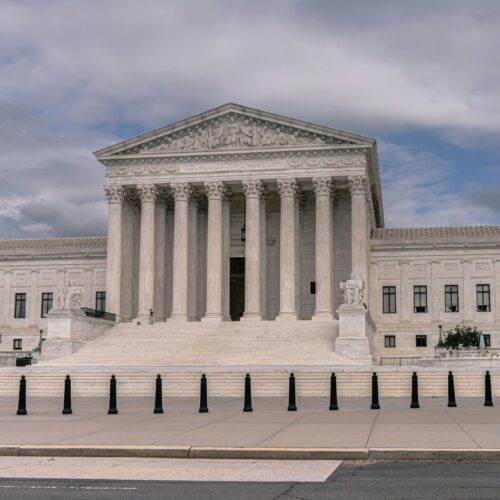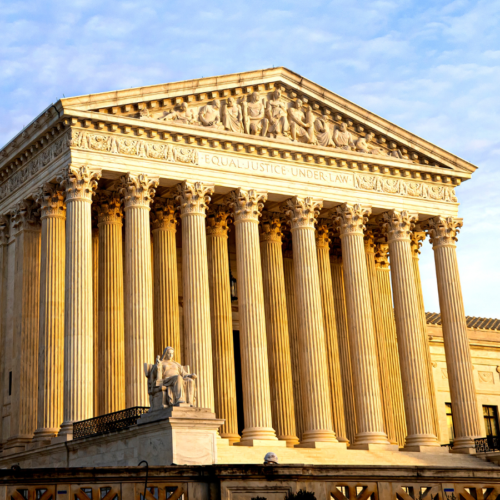Supreme Court Preview – Midterm Update
By: Lisa Soronen, State and Local Legal Center, Washington, D.C.
The State and Local Legal Center (SLLC) files Supreme Court amicus curiae briefs on behalf of the Big Seven national organizations representing state and local governments.
The Supreme Court’s docket is full for the 2021-22 term. The SLLC Supreme Court Preview for State Governments summarizes a number of important cases for the states the Supreme Court agreed to hear this term as of July 2021, including abortion, guns, and vouchers.
This article summarizes three more interesting cases for state governments to be decided this term—one involving federal agency authority to regulate power plants and two involving states trying to intervene in litigation.
For more information, register for the free March 17 SLLC Mideterm Webinar.

In West Virginia v. EPA the Supreme Court will decide whether the Environmental Protection Agency (EPA) had the authority to issue the Clean Power Plan (CPP) Rule.
The Clean Air Act directs EPA to regulate powerplants that cause or contribute significantly to air pollution. In 2015 EPA adopted the CPP which regulates greenhouse gas emissions from existing fossil-fuel-fired powerplants. A key “building block” of CPP was “generation shifting” where emissions reductions occur because “the source of power generation shifts from higher-emission power plants to less-polluting sources of energy.”
In 2019 EPA repealed the CPP and replaced it with the Affordable Clean Energy (ACE) Rule. EPA concluded it had to repeal the CPP because “generation shifting” operates off site of power plants and the “plain meaning” of the Clean Air Act “unambiguously” limits emissions reduction measures to only those “that can be put into operation at a building, structure, facility, or installation.”
A number of states, local governments, and others challenged the ACE Rule’s conclusion that emissions reduction measures must be implemented at and applied to power plants. West Virginia and others challenged the ACE Rule on other grounds.
The D.C. Circuit held that EPA didn’t act lawfully in adopting the ACE Rule because repealing the CPP “hinged on a fundamental misconstruction” of the Clean Air Act, that generation shifting is not allowed.
According to West Virginia, among other problems, the D.C. Circuit “gave short shrift to the clear-statement canons.” West Virginia points to Judge Walker’s dissent in this case where he opined that the lack of a clear statement from Congress allowing generation-shifting is fatal to the CPP.
In Arizona v. San Francisco City and County of California the Supreme Court will decide whether states with interests should be permitted to intervene to defend a rule when the United States ceases to defend the rule.
One of the grounds for inadmissibility into the United States per the Immigration and Nationality Act (INA) is if a person is likely to become a “public charge.” This term isn’t defined in the INA. Using the notice and comment rulemaking process, in 2019 the Trump administration defined “public charge” more broadly than guidance from the Clinton administration.
San Francisco and many others sued the Trump administration over the definition in federal courts throughout the United States.
In February of 2021 the Supreme Court agreed to hear a case from the Second Circuit to decide whether the definition was unlawful. Shortly thereafter, the Biden administration decided not to defend the rule. It sought and received dismissal of all the challenges to the rule, including the challenge in the Supreme Court.
In this case the Ninth Circuit had affirmed district court preliminary injunctions concluding the 2019 public charge rule was likely contrary to law.
In January of 2021 the United States asked the Supreme Court to review the Ninth Circuit decision. On March 9, 2021, before the Court acted on the petition, the United States and San Francisco jointly asked the Supreme Court to dismiss the Ninth Circuit petition, which it did.
The next day Arizona and 12 other states, which had not participated in the case previously, asked if they could intervene in the Ninth Circuit case so that they could petition the Supreme Court to review the Ninth Circuit decision.
The Ninth Circuit denied Arizona’s motion to intervene without issuing an opinion.
A dissenting judge would have granted it. Applying the Federal Rules of Civil Procedure governing intervening, Judge Van Dyke concluded Arizona met all the requirements which include timeliness, having a “significant protectable interest” related to the litigation that may be impaired or impeded depending how the litigation is resolved, and whether existing parties will adequately represent the applicant’s interests.
In Berger v. North Carolina State Conference of the NAACP the Supreme Court will decide whether the North Carolina legislature has a right to intervene in a lawsuit to defend North Carolina’s voted ID law when the North Carolina Attorney General is already defending the law.
In December of 2018 North Carolina adopted a new voter ID law. The North Carolina NAACP sued members of the state elections board in federal court claiming the law discriminates against black and Latino votes in violation of Section 2 of the Voting Rights Act. The North Carolina Attorney General represents state elections board members in the litigation.
The President Pro Tempore of the North Carolina Senate and the Speaker of the North Carolina House of Representatives (Petitioners) sought to intervene in this lawsuit on behalf of the North Carolina General Assembly.
Federal Rule of Civil Procedure 24 allows intervention as a matter of right where, among other factors, a potential intervenor’s interest is not adequately represented by the existing parties.
The Fourth Circuit applies a presumption of adequate representation when “the party seeking intervention has the same ultimate objective as a party to the suit.” The Fourth Circuit concluded that the district court didn’t abuse its discretion in concluding that the Attorney General has adequately defended the law. In their brief asking the Court to decide this case the Petitioners argue a “presumption of adequate representation is inconsistent with the text of Rule 24.”
Even though the Clean Power Plan has long been defunct, West Virginia v. EPA is one of the most important environmental cases the Court has heard in a long time. And, depending on the Court’s holding and rationale, it could be one of the most important administrative law cases decided recently as well. It is rare for the Court to hear to any—much less three—state intervention cases. Read about the other intervention case in the SLLC Supreme Court Preview for State Governments. All of these cases will be decided by the end of June 2022.


